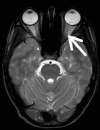Vestibular Rehabilitation Considerations in an Uncommon Optic Neuritis: A Case Report
- PMID: 38435174
- PMCID: PMC10908412
- DOI: 10.7759/cureus.53423
Vestibular Rehabilitation Considerations in an Uncommon Optic Neuritis: A Case Report
Abstract
Optic neuritis is an inflammatory condition that leads to inflammation and damage to the optic nerve, causing visual disturbances and pain. It is commonly associated with disorders such as multiple sclerosis and often manifests as sudden, unilateral loss of vision or blurred vision. This disorder can affect individuals of any age and may lead to decreased binocular vision, potentially resulting in difficulties with depth perception and visual coordination. Physiotherapy plays a crucial role in treating optic neuritis by addressing various aspects of the illness. We report the case of a 14-year-old male with diminution in both eyes, which was sudden in onset and painless in nature, with no history of falls, trauma, or diabetes. Magnetic resonance imaging reveals hyperintensity on short-tau inversion recovery (STIR) with mild contrast enhancement in the posterior aspects of the bilateral optic nerves (intracranial part), extending to the optic chiasm in optic neuritis. Physiotherapists employ a range of techniques to enhance the patient's overall well-being, including gaze stability exercises, eye-hand coordination exercises, and habituation exercises aimed at improving visual tracking and coordination. Additionally, physiotherapy can help reduce related symptoms such as muscle weakness, balance issues, and posture problems caused by impaired visual perception. Physical therapists endeavor to improve the quality of life for patients with optic neuritis by enhancing functional independence and contributing to a more effective approach to treatment. Notably, there was an improvement in visual scanning, spatial awareness, and eye movement control in this case.
Keywords: gaze stability exercises; neurophysiotherapy; optic neuritis; physiotherapy rehabilitation; strabismus.
Copyright © 2024, Dangare et al.
Conflict of interest statement
The authors have declared that no competing interests exist.
Figures


Similar articles
-
Optic neuritis: correlation of pain and magnetic resonance imaging.Ophthalmology. 2003 Aug;110(8):1646-9. doi: 10.1016/S0161-6420(03)00477-9. Ophthalmology. 2003. PMID: 12917187
-
Retrobulbar Optic Neuritis Post Typhoid fever: Atypical Case Report.Rom J Ophthalmol. 2023 Jan-Mar;67(1):73-76. doi: 10.22336/rjo.2023.13. Rom J Ophthalmol. 2023. PMID: 37089797 Free PMC article.
-
Leber's hereditary optic neuropathy following unilateral painful optic neuritis: a case report.BMC Ophthalmol. 2020 May 18;20(1):195. doi: 10.1186/s12886-020-01461-6. BMC Ophthalmol. 2020. PMID: 32423393 Free PMC article.
-
Disorders of vision in multiple sclerosis.Clin Exp Optom. 2022 Jan;105(1):3-12. doi: 10.1080/08164622.2021.1947745. Epub 2021 Aug 4. Clin Exp Optom. 2022. PMID: 34348598 Review.
-
Ophthalmology update for primary practitioners. Part I. Update on optic neuritis.Dis Mon. 2000 Aug;46(8):508-32. doi: 10.1016/s0011-5029(00)90013-0. Dis Mon. 2000. PMID: 10969715 Review.
References
-
- The Optic Neuritis Treatment Trial. Putting the results in perspective. The Optic Neuritis Study Group. Beck RW, Trobe JD. https://pubmed.ncbi.nlm.nih.gov/8574355/ J Neuroophthalmol. 1995;15:131–135. - PubMed
-
- Optic neuritis: a review. Shams PN, Plant GT. https://pubmed.ncbi.nlm.nih.gov/19878630/ Int MS J. 2009;16:82–89. - PubMed
-
- The effect of vision impairment on dynamic balance. Collings R, Paton J, Glasser S, Marsden J. J Foot Ankle Res. 2015;8:0.
Publication types
LinkOut - more resources
Full Text Sources
